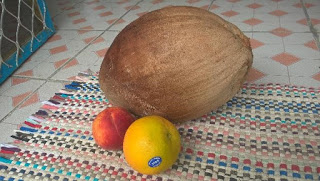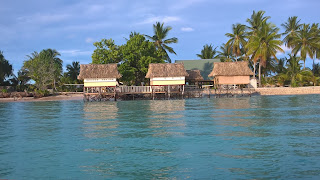Food
If you’ve been out here in Kiribati a while and spend some
time with the local expats/i-Matung, one peculiarities you will soon notice is
that one of the main topics of conversation is…food! That’s right, one of the main things we talk
about is food, or more importantly what is available, where and for how much.
Almost all the food here is imported. There is next to no
land to grow anything on and even if there were the soils are coral sand, great
for coconut palms but bugger all use for much else. The Taiwanese government
has a small agricultural ttraining centre where they do grow/produce amazing variety of things and are teaching the locals how to grow more varieties of vegetables but this
process has been extremely labour intensive- even getting the sand to a
reasonable quality of soil using seaweed and other compostable materials was a
major mission. And even though they are producing more varieties of vegetables-
which are donated to local schools/charities- there are no bees here to
pollinate the flowers so it must be done by hand.
 |
| 5 plus a day? I try to have a piece of fruit or two each week... the one and only time I ever found peaches out here. |
Don’t get me wrong, some foods are grown. Pumpkin seems to
be one of the hardiest, easiest to grow plants, so pumpkin is often included in
meals at restaurants- usually boiled. Cucumbers too are reasonably easy to get
hold of, not sure if they are grown locally, or imported from one of the outer
islands, but I suspect the latter. Bananas can be found in local markets, again
typically imported from the other islands. On North Tarawa where there is a lot less pressure for land villagers do
grow some crops including Taro. Locally, a few cherry tomatoes can be found
along with limes, pawpaw etc but not in any decent quantities.
So, as I said most food is imported. The most common
vegetables to be found are onions and carrots, both imported from NZ or Aust.
Much to my surprise apples are pretty common most of the time and found in
refrigerators at the shops (about $1.20-$1.60 each) but aren’t exactly the
fruit I was expecting to find at the equator! Food brought in by plane gets only
so far up the atolls from the airport while food imported via the port makes it
part way down from the other end. Each importer buys their own products and
tend to buy the cheapest things available in Australia and New Zealand (so the
quality of the produce is often not that good by the time they arrive on
island) and mark ups can be a tad…extreme. Recently cabbages were $35 each! So
you are often at the mercy of the importers as to what can be found on island
and no two places stock the same things. It can also be totally random what you
find. I was out for a bike ride one Saturday and stopped to get a drink at one
of the stores close to the airport and they had a fridge full of fresh
kiwifruit. Of course I bought one but have never seen kiwifruit again anywhere on
South Tarawa.
So shopping for groceries ends up a bit of a scavenger hunt,
travelling to half a dozen small shops and the larger “supermarkets” to see
what is available and there can be sometimes rather large fluctuations in price
between the different importers. Going from shop to shop for groceries is an
important part of the weekly routine, but one that I actually do quite enjoy. Some
of the main stores are locally in Betio where I work, and they often have more variety
and different stock to their branches in Bairiki, closer to
where I live, so I’ll often pop out at lunchtime to source groceries while at wrk and that has made life a bit easier.
For the i-Kiribati population, rice is the staple of the
diet. It is heavily subsidised by the government and eaten in vast quantities-
along with locally caught fish, but people put few vegetables with it and
nutrition out here in general is pretty poor. Rather basic nutrition-less crackers
(Punja’s breakfast crackers) and instant noodles- which are often eaten raw as
some sort of snack- are some of the most common foods for my workmates and I
assume many other people too. The i-Kiribati are quite short. Most people are
under 5 ½ ft (170 cms) tall. This is no doubt is partly genetic but a large part
of it is probably due to poor nutrition and the resulting stunting of growth in
the important growth years during childhood. A rather sad and sobering fact.
So, food here is a big deal and for us i-Matung and the bush
telegraph, or in this particular case the modern equivalent known as the South
Tarawa Expats Facebook page, quickly gets informaiton out when something out of
the ordinary arrives on island and which shop it is found at.
As well as having to rely on whatever the shops decide to
import food supplies are at the whim of the government. There was great
excitement two weeks ago with news that that potatoes had been spotted at Coral Ace
in Betio (one of the larger stores)! Potatoes? Yes this humble staple of
western diets was banned by the government and has been unavailable for at
least a year! Why? Apparently to protect the local potato industry. What potato
industry you may ask Exactly! There isn’t one! Ironic isn’t it? However,
somebody in the government took exception to the quality of potatoes being imported
(remember when I said earlier importers try to get the cheapest products-
including produce, at the cheapest price, well that’s what you get poorer quality food!). Anyway, the story as told by other i-Matung (so it must be true), is
that someone took exception to the quality of the imported potatoes and they’ve
been banned but now apparently the ban has been lifted- at least in the case of
New Zealand grown spuds. Australia potatoes are still banned but with the
quantities imported of ANY potatoes being so small I doubt the Aussies are even
aware of this. And as for the local potato market? Well it is still non-existent.
So imagine my surprise when I sat down to lunch at work a couple of Monday's ago and there before me sitting in their pale white, slightly gooy looking glory
was a plate of mashed potatoes. Were they lumpy? Hell yes but they were also
bloody delicious! How long will spuds last on island? Who knows but after that lunch I went down to Coralace and bought myself four small potatoes for
$4.50. Yes, 500 grams of spuds for $4.50 or $9.00 a kg but who cares! It’s the
little things that remind you of home that can make or break your day. The
number one rule of shopping here being if you see something buy it, you don’t
know when more are likely to arrive on island and once sold out they are gone,
sometimes for weeks or months at a time.
 |
| Yes I am sad. One of those sad, sad food shots but hey it was bloody mashed spud and broccoli ! |
We had a similar story recently with mince, it too was spotted
in Moel’s, another of the local supermarkets, a few weeks back and this too as
BIG NEWS on the island as mince had not been seen anywhere for over a year. So
again the local i-Matung community descended en-mass to stock up on mince at
least $13 per kg. Now however, it seems to have disappeared again and who knows when more will arrive on island. Meanwhile, I eagerly await an update on the bush telegraph.
Craig





Comments
Post a Comment